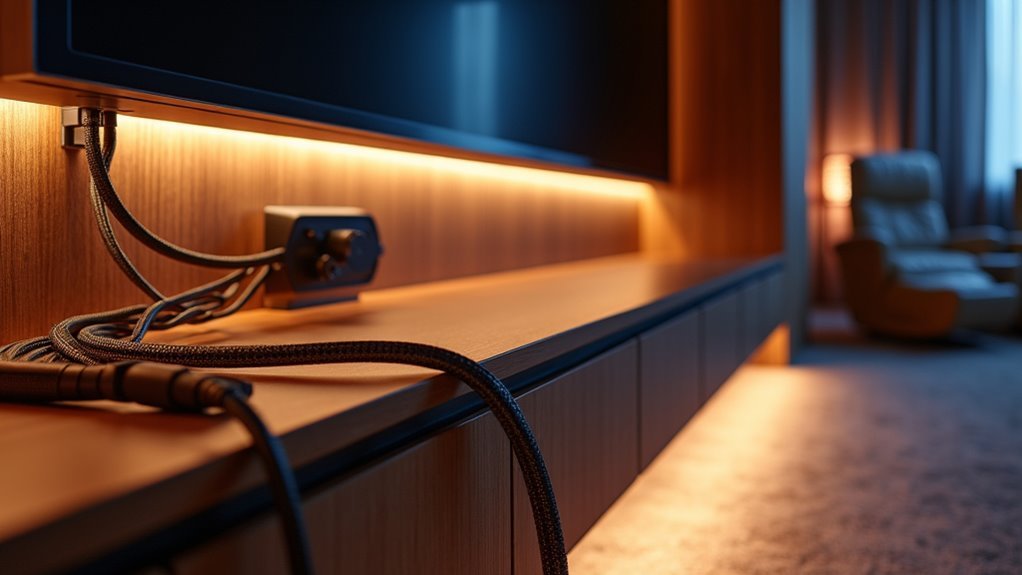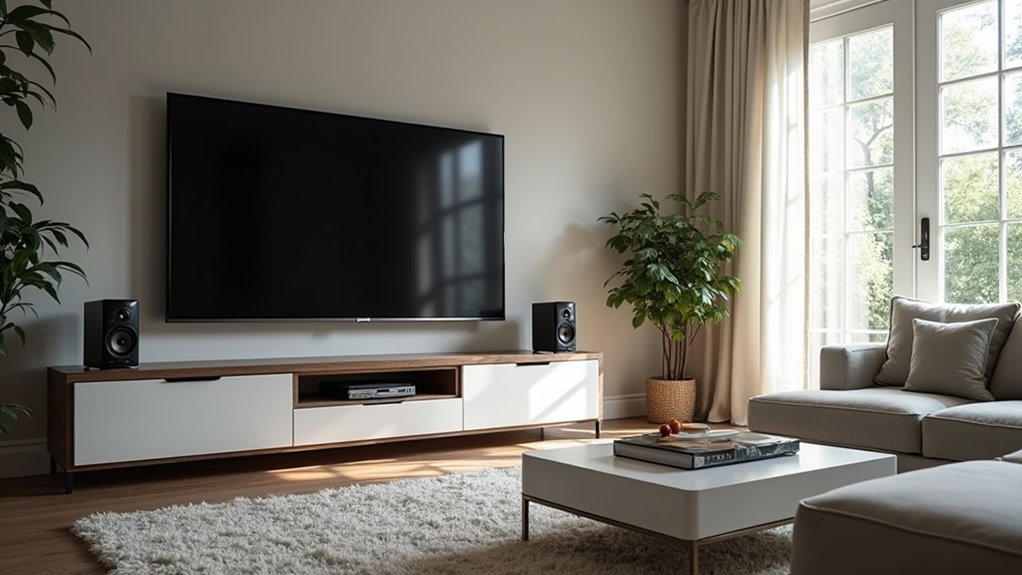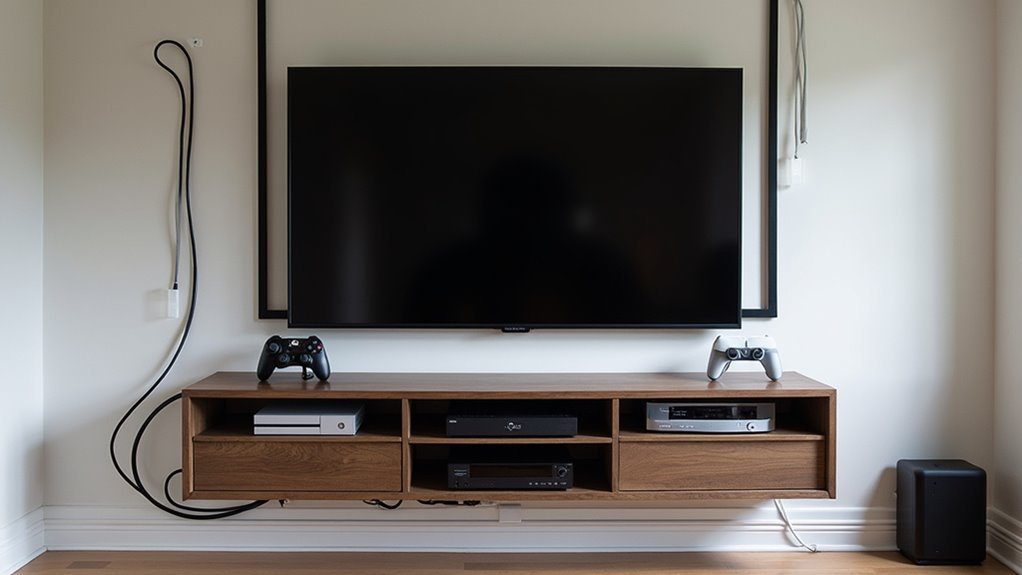You’ve probably noticed how your streaming quality drops during peak hours or how your soundbar occasionally cuts out during action scenes. These frustrations aren’t just inconveniences—they’re symptoms of inadequate home entertainment wiring that’s struggling to keep up with today’s demanding content standards. While you might assume your internet connection is the culprit, the real bottleneck often lies in the cables and infrastructure you can’t see.
The Growing Home Theater Market and Infrastructure Demands

As streaming services proliferate and technology advances, the global home theater market is surging toward an impressive $13,050.2 million by 2025, with North America leading this 8.3% annual growth trajectory.
This explosive demand isn’t just about bigger screens or better speakers—it’s fundamentally reshaping infrastructure requirements in your home.
You’re witnessing a transformation where proper home theater wiring becomes the backbone of modern entertainment systems. As homeowners increasingly invest in sophisticated audio-visual setups, the need for robust wiring infrastructure intensifies.
Your entertainment system’s performance directly depends on quality connections that support today’s advanced features like 4K video streaming and multi-channel surround sound.
Quality wiring infrastructure is the critical foundation that determines whether your home theater delivers premium 4K and surround sound performance.
This market expansion means you can’t afford to overlook wiring fundamentals when planning your home theater investment.
Essential Cable Types for Modern Entertainment Systems
You’ll need to choose between HDMI and component cables based on your specific setup requirements, as each offers distinct advantages for video transmission.
Your audio cable selection becomes equally critical, with optical and coaxial options providing different benefits for sound quality and compatibility.
You must also consider cable length and wire gauge specifications to guarantee peak signal integrity throughout your entertainment system.
HDMI Vs Component
When choosing between HDMI and component cables for your entertainment system, you’re deciding between modern digital convenience and traditional analog reliability. HDMI cables deliver both high-definition video and multichannel audio through one connection, eliminating the need for separate audio cables. Component cables require three video connections plus additional audio cables, creating a more complex setup.
| Feature | HDMI | Component |
|---|---|---|
| Video Quality | Up to 4K resolution | High-definition analog |
| Audio Support | 32 channels built-in | Requires separate audio cables |
| Connections | Single cable | Three video + audio cables |
| Advanced Features | Ethernet, 3D gaming | Video transmission only |
HDMI’s versatility makes it essential for modern devices like Blu-ray players and gaming consoles, streamlining your entertainment experience.
Audio Cable Options
While video quality often takes center stage in entertainment discussions, your audio setup deserves equal attention to create a truly immersive experience.
Here are your primary audio cable options:
- HDMI cables – Transfer both audio and video simultaneously, supporting up to 32 audio channels and high-definition formats like 4K for extensive entertainment setups.
- Optical audio cables – Utilize laser technology for digital audio transmission, supporting up to 5.1 surround sound, making them perfect for home theater audio components.
- Coaxial cables – Effectively transmit audio and video signals over shorter distances, providing reliable connectivity within compact home theater systems.
- Component audio connections – Work alongside component video cables to deliver quality analog audio for older equipment lacking digital inputs.
Length and Gauge
Resistance becomes your enemy when selecting cable length and gauge for your entertainment system. Shorter cables naturally reduce resistance, delivering cleaner signals to your components.
When you’re planning longer runs, you’ll need thicker wires with lower gauge numbers to maintain signal integrity. For distances under 50 feet with 8-ohm speakers, 16-gauge wire works perfectly.
However, when you’re running cables over longer distances, you should upgrade to 12 or 14-gauge options. These thicker wires compensate for the increased resistance that comes with greater length.
Your budget considerations matter too. You can use standard-quality cables for short connections, but investing in higher-quality options for longer runs prevents signal degradation.
HDMI and Digital Connection Standards
You’ll encounter several HDMI cable types when setting up your home theater, each designed for specific performance levels and device compatibility.
Modern HDMI connections can handle impressive 4K video resolution while simultaneously transmitting crystal-clear digital audio signals.
These cables support up to 32 audio channels, giving you the flexibility to create complex surround sound configurations that rival commercial theater experiences.
HDMI Cable Types
Because modern home entertainment systems demand crystal-clear audio and video transmission, HDMI cables serve as the backbone of your digital connections.
Understanding different HDMI cable types guarantees you’re getting peak performance from your equipment.
When selecting HDMI cables, you’ll encounter these key standards:
- HDMI 1.4 – Supports 4K video at 30Hz, perfect for basic ultra-high-definition content.
- HDMI 2.0 – Delivers enhanced 18 Gbps bandwidth, enabling 4K at 60Hz with 32 audio channels.
- HDMI 2.1 – Provides cutting-edge 8K resolution at 60Hz plus Dynamic HDR capabilities.
- High-quality construction – Features proper shielding to prevent signal degradation over long distances.
You’ll benefit from backward compatibility, meaning newer HDMI cables work with older devices.
However, performance will match your oldest component’s capabilities, so invest in quality cables that won’t bottleneck your system’s potential.
4K Video Support
While 4K video represents the current gold standard for home entertainment, achieving its full potential requires understanding how HDMI and digital connection standards work together.
Your wiring choices directly impact whether you’ll experience true 4K quality or disappointing signal degradation.
HDMI 2.1 delivers the bandwidth necessary for 4K content at higher refresh rates, supporting Dynamic HDR that adapts brightness and color frame-by-frame.
You’ll need compatible cables throughout your system’s wiring to maintain signal integrity from source to display.
Unlike analog connections, digital standards eliminate interference and preserve picture quality across longer cable runs.
When you’re planning your entertainment wiring, guarantee every HDMI cable meets the bandwidth requirements of your 4K devices to release their full potential.
Audio Channel Capacity
Beyond delivering stunning visuals, your HDMI connections handle impressive audio capabilities that transform your home theater’s sound experience.
Modern HDMI cables support up to 32 audio channels, providing exceptional flexibility for complex surround sound systems.
Here’s what makes HDMI audio superior:
- High Bandwidth Support – HDMI 2.1 delivers up to 48 Gbps, enabling uncompressed 8K video alongside advanced audio formats.
- Enhanced Audio Return Channel (eARC) – Transmits high-quality audio from your TV back to receivers without additional cables.
- Digital Signal Integrity – Minimizes signal loss and interference compared to analog connections.
- Future Compatibility – Guarantees your setup works with current and emerging audio technologies.
You’ll experience superior sound quality through digital connections that maintain audio fidelity throughout transmission.
Analog Audio and Video Cable Options
The foundation of many home entertainment systems still relies on analog audio and video cables, especially when you’re working with older devices like VCRs, DVD players, and standard-definition televisions.
You’ll find that stereo RCA cables remain essential for connecting various audio devices and transmitting multichannel analog audio in home setups.
When you’re dealing with video connections, composite cables combine signals into a single channel, though they’re becoming less common.
However, S-Video cables offer superior quality by separating luminance and chrominance signals, delivering clearer images for standard-definition displays.
While HDMI dominates today’s market, you shouldn’t overlook analog options.
Understanding these connections proves vital when you’re integrating vintage equipment into modern home theater systems, ensuring compatibility across different generations of devices.
Critical Factors When Selecting Entertainment Cables

Selecting the right cables for your home entertainment system requires careful consideration of several key factors that directly affect performance and longevity.
When choosing cables for your setup, you’ll need to evaluate these critical elements:
- Signal compatibility – HDMI cables supporting 4K video and 32 audio channels are essential for high-definition setups, while guaranteeing your cables match your equipment’s capabilities.
- Conducting material – Gold-plated connectors deliver the best signal quality, though copper remains the most economical and widely used option for most installations.
- Cable gauge and resistance – Lower resistance cables like 12 or 14-gauge provide better performance for long runs and high-power speakers.
- Future-proofing features – Advanced capabilities supporting 3D gaming and Ethernet guarantee your investment remains relevant as technology evolves.
Understanding Cable Materials and Signal Quality
When building your home entertainment system, the materials used in your cables directly impact the quality of audio and visual signals reaching your components. Understanding cable materials helps you make informed decisions that enhance your viewing experience.
Oxygen-free 99.99% copper provides pristine signal transfer with minimal interference, though it costs more than standard options. Gold-plated connectors offer superior signal quality through low resistance, but they’re pricier than copper alternatives. Copper-Clad Aluminum (CCA) delivers excellent conductivity while balancing cost considerations.
| Material Type | Signal Quality | Cost Factor |
|---|---|---|
| Oxygen-Free Copper | Excellent | High |
| Gold-Plated Connectors | Superior | Very High |
| Standard Copper | Good | Moderate |
| Copper-Clad Aluminum | Very Good | Low |
| Basic Materials | Fair | Very Low |
Wire thickness also affects resistance—thicker gauges reduce signal loss on longer runs.
Planning Your Entertainment System Wiring Layout

After selecting quality cable materials, you’ll need to map out how these connections work together throughout your entertainment space.
Creating a thorough wiring layout serves as your system’s nervous system, guaranteeing each component connects efficiently for maximum performance.
Understanding your specific wiring needs starts with documenting your equipment and desired configurations:
- Create a visual wiring map showing all connection points between devices, accommodating speaker setups like 5.1 or 7.1 systems.
- Identify cable types and quantities required for each piece of equipment to confirm compatibility.
- Plan connection stages by starting with input devices, then moving to your AV receiver, and finally to displays.
- Verify all connections including positive and negative wire identification to prevent signal loss and achieve peak sound quality.
Step-by-Step Connection Process for Home Theaters
Once you’ve finalized your wiring layout, you’re ready to begin the actual connection process that’ll bring your home theater to life.
Start by creating a wiring map to visualize connections and identify necessary cable types for device compatibility. Connect input devices like Blu-ray players and cable boxes to your AV receiver first, then link the receiver’s video output to your TV or projector.
Create a detailed wiring map first, then systematically connect input devices to your AV receiver before linking to your display.
Connect speakers in stages, carefully matching positive and negative terminals to maintain sound quality. Measure cable lengths precisely to prevent excess slack or tension that causes signal loss.
After completing all connections, perform a thorough check ensuring cables are secure and devices function without interruptions, delivering the exceptional home theater experience you’ve planned.
Professional Cable Management and Concealment Techniques
While establishing connections forms the foundation of your home theater, achieving a truly professional appearance requires mastering cable management and concealment techniques that transform visible wire chaos into an organized, aesthetically pleasing setup.
Effective cable management enhances both safety and performance while creating a cleaner environment. Consider these professional techniques:
- Install cable raceways and wall plates to hide multiple wires behind wall-mounted displays, providing a finished appearance.
- Plan ideal wiring routes through walls or along baseboards to minimize visibility and eliminate trip hazards.
- Utilize professional installation services for complex setups requiring customized solutions without compromising system performance.
- Maintain proper ventilation paths around equipment while organizing cables to prevent overheating and electrical interference.
These strategies guarantee your investment delivers maximum aesthetic appeal and operational longevity.
Power Requirements and Electrical Considerations
Beyond the visual appeal of organized cables lies the essential foundation of your home theater system: proper electrical planning and power management. You’ll need to calculate power requirements carefully, as overloaded circuits can trip breakers and disrupt your entertainment experience. Most home breakers handle 15 amps, so monitor your total power draw across all components.
These electrical considerations become vital when you’re running multiple devices simultaneously. Confirm all equipment connects to the same electrical leg to prevent issues.
You should install dedicated circuits to minimize interference from household appliances like microwaves and refrigerators, which can introduce noise into your audio and video signals.
Don’t forget proper ventilation for your equipment to prevent overheating and maintain long-term reliability.
Dedicated Circuits for Optimal Performance
When you install dedicated circuits for your home theater components, you’ll dramatically improve both audio and video quality by eliminating electrical interference from household appliances.
These specialized circuits isolate your equipment from noisy devices that can degrade performance.
Specialized circuits create a barrier between your sensitive home theater equipment and interference-generating household appliances that compromise audio and video quality.
Dedicated circuits provide four key advantages for your setup:
- Eliminate hum and video issues by guaranteeing all components draw power from the same electrical panel leg
- Handle larger amplifiers and multiple components without overloading your system
- Prevent tripped breakers that disrupt your entertainment experience
- Enable controlled power distribution for consistent, reliable performance
You should consult with a qualified electrician to design dedicated circuits that match your specific equipment needs.
This investment guarantees your high-performance home theater operates at its full potential.
Pre-Wiring Benefits for Future Technology Upgrades
Pre-wiring your home entertainment system before drywall installation creates a foundation that adapts effortlessly to tomorrow’s technological advances. You’ll eliminate the need for extensive renovations when upgrading equipment, as cables are already strategically positioned throughout your home. This foresight supports multi-room audio/video zones and advanced automation systems without visible wiring complications.
When considering pre-wiring benefits for future technology upgrades, these important factors demonstrate the value:
| Aspect | Without Pre-Wiring | With Pre-Wiring |
|---|---|---|
| Installation | Complex, disruptive renovations | Seamless equipment upgrades |
| Flexibility | Limited placement options | Versatile positioning anywhere |
| Future-Proofing | Costly modifications needed | Ready for new technology |
You’ll minimize installation risks while maximizing placement flexibility, ensuring your home stays current with evolving entertainment technology without major construction efforts.
Safety Considerations and Professional Installation
When you’re installing home entertainment wiring, you’ll face serious electrical hazards that can result in shock, injury, or fire if handled improperly.
You shouldn’t attempt this work yourself since high-voltage electrical systems require specialized knowledge and training to guarantee compliance with safety standards.
You’ll benefit greatly from expert installation that not only prevents dangerous accidents but also delivers peak performance through proper circuit design and professional-grade components.
Electrical Hazard Prevention
While home theater systems deliver impressive audiovisual experiences, they also present significant electrical hazards that you can’t afford to ignore. High voltage components and complex wiring create serious risks including electrocution and fire hazards when improperly handled.
To protect your home and family, you must implement these essential prevention measures:
- Never attempt DIY electrical work – Leave all wiring to licensed electricians who understand safety protocols and local codes.
- Calculate power loads carefully – Prevent circuit overloads that can trip breakers and create fire risks.
- Install dedicated circuits – Reduce interference while preventing dangerous power fluctuations.
- Schedule regular maintenance – Professional evaluation of your electrical system guarantees ongoing safety and proper equipment ventilation.
Professional oversight isn’t optional—it’s crucial for safe operation.
Expert Installation Benefits
Although the temptation to handle home entertainment wiring yourself might seem appealing, professional installation delivers benefits that extend far beyond basic functionality.
Expert installation benefits include guaranteed code compliance, protecting you from potential violations and safety issues. You’ll experience superior sound quality through optimized speaker placement and premium cable selection that professionals understand intimately.
Experienced technicians assess your space to create efficient wiring routes while preserving your home’s aesthetic appeal. They use high-quality connectors that dramatically improve signal performance compared to standard alternatives.
Most importantly, you gain peace of mind knowing experts can troubleshoot problems immediately during installation, ensuring your entertainment system operates flawlessly from day one without costly future repairs.
Long-Term Value and Performance Optimization
Because technology advances rapidly in the home entertainment industry, your wiring decisions today will determine whether you’re enjoying cutting-edge performance five years from now or dealing with costly upgrades and compatibility issues.
Quality wiring infrastructure provides exceptional long-term value by maintaining signal integrity as your home audio system evolves.
Your investment in proper wiring delivers sustained performance through:
- Signal preservation – High-quality cables maintain audio fidelity and video clarity over years of use.
- Future compatibility – Correct gauge wiring accommodates emerging technologies without complete system overhauls.
- Reduced interference – Professional-grade cables minimize signal loss that degrades performance over time.
- Flexible upgrades – Well-planned infrastructure supports seamless integration of new components.
This foundation guarantees your entertainment system continues delivering superior performance while protecting your investment against technological obsolescence.
Frequently Asked Questions
What Is the Reason for Home Theatre Wiring Not to Run Along With the Power Wiring?
You shouldn’t run home theater wiring alongside power wiring because electromagnetic interference from electrical cables degrades your audio and video signal quality, causing unwanted hum, distortion, and reduced performance in your system.
Why Is House Wiring Needed?
You need house wiring to connect electrical power throughout your home, enabling lights, outlets, and appliances to function safely. It’s the foundation that distributes electricity from your main panel to every room.





Leave a Reply